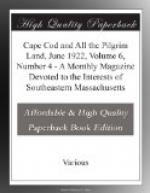The origin of the name “Wellfleet” has always been a source of lively interest to those who delight to delve to the roots of things historical. So many of our early towns in Massachusetts were named by the Englishmen who settled them for English towns familiar to them before they came oversea, that England is the natural source from whence such a Saxon-English name as Wellfleet might come.
After forty years of desultory search by the writer, the problem is yet unsolved, though a good Yankee guess may not come very far out of the way.
When that part of old Nawsett now Wellfleet was first settled it was noted for the abundance of shell fish in the harbor and creeks, or cricks as then called, and oysters were both especially plentiful and choice.
In England, on the coast of Essex, and not far from the Thames, was a stretch of oyster beds noted in the sixteenth century for their production of oyster different from all other locations and revered by epicures of those far-away times to be the luscious complement necessary to their royal as well as more common plebeian feasts. But we had best let old John Norden, who in 1594 published the results of his life-long investigations into the history of Essex, tell the story, which here is given verbatim as it appears in his work, “SPECTLI BRITTANNIE pars.”
“Some part of the sea shore of Essex yealdeth the beste oysters in England, which are called Walflete oysters: so called of a place in the sea; but of which place in the sea it is, hath been some disputation. And by the circumstances that I have observed thereof in my travail, I take it to be the shore which lieth betwene St. Peter’s chappell and Crowch the bredthe onlie of Denge hundred, through which upon the verie shore, was erected a wall for the preservation of the lande. And thereof St. Peter’s on the wall. And all the sea shore which beateth on the wall is called Walfleet. And upon that shore on, and not elswher, but up in Crouche creeke, at the ende of the wall, wher also is an ilande called commonlie and corruptlie Walled (but I take it more trulie Wallflete) Island, wher and about which ilande thys kinde of oyster abonndeth. Ther is greate difference betwene theis oysters and others which lie ypon other shores, for this oyster, that in London and els wher carieth the name of Walflete is a little full oyster with a verie greene finn. And like vnto theis in quantetie and qualitie are none in this lande, thowgh farr bigger, and for some mens diettes better.”
From the above we may understand that Wellfleet oysters, which have been celebrated in the English markets for between three and four hundred years, might easily have led the settlers of Nawsett to believe that at Billinsgate, they had a new Wallfleet Oyster bed. The fact that Wallfleet oysters were marketed at Billinsgate, always the big fish market of the Londoners, and that our Wellfleet was at first known as Billingsgate, seems more than a mere coincidence.




